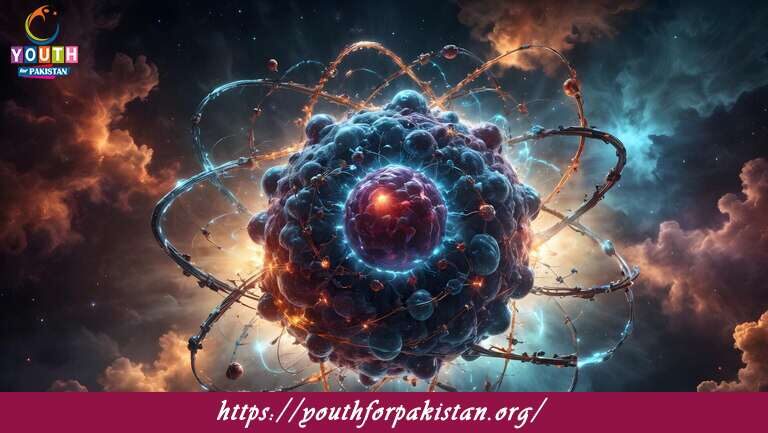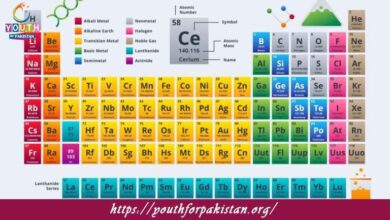12th Class Physics Chapter 21 MCQs with Answers

Boost your understanding of Nuclear Physics with 12th Class Physics Chapter 21 MCQs. Topics include nuclear reactions, radioactivity, and energy production. Keywords like nuclear physics quiz, radioactivity MCQs, and nuclear energy test help optimize rankings.
The nucleus of an atom is composed of:
a) Protons and electrons
b) Protons and neutrons
c) Electrons and neutrons
d) Protons, electrons, and neutrons
The number of protons in the nucleus of an atom is called the:
a) Atomic mass number
b) Atomic number
c) Mass number
d) Neutron number
The total number of protons and neutrons in the nucleus of an atom is called the:
a) Atomic mass number
b) Atomic number
c) Mass number
d) Neutron number
The mass of a proton is approximately equal to the mass of a(n):
a) Electron
b) Neutron
c) Alpha particle
d) Deuteron
The charge of an electron is:
a) Positive
b) Negative
c) Neutral
d) Zero
The charge of a proton is:
a) Positive
b) Negative
c) Neutral
d) Zero
The number of neutrons in the nucleus of an atom is given by:
a) Mass number – Atomic number
b) Atomic number – Mass number
c) Atomic number + Mass number
d) Mass number + Atomic number
The total number of nucleons (protons and neutrons) in a nucleus is called:
a) Atomic number
b) Mass number
c) Nuclear number
d) Nucleon number
The atomic mass unit (amu) is defined as:
a) The mass of an electron
b) The mass of a proton
c) One-twelfth the mass of a carbon-12 atom
d) The mass of a neutron
The strong force is responsible for:
a) Radioactive decay
b) Nuclear fusion
c) Nuclear fission
d) Holding protons and neutrons together in the nucleus
The process by which a nucleus spontaneously decays and emits radiation is called:
a) Nuclear fission
b) Nuclear fusion
c) Radioactive decay
d) Nuclear transmutation
Which of the following particles is the most penetrating type of ionizing radiation?
a) Alpha particles
b) Beta particles
c) Gamma rays
d) Neutrons
The emission of an alpha particle from a nucleus reduces the atomic number by:
a) 1
b) 2
c) 3
d) 4
The emission of a beta particle from a nucleus increases the atomic number by:
a) 1
b) 2
c) 3
d) 4
The process of combining two light nuclei to form a heavier nucleus is called:
a) Nuclear fission
b) Radioactive decay
c) Nuclear fusion
d) Nuclear transmutation
The process by which a heavy nucleus splits into two lighter nuclei is called:
a) Nuclear fusion
b) Radioactive decay
c) Nuclear fission
d) Nuclear transmutation
The mass defect in a nucleus is the difference between the total mass of the nucleons and the:
a) Mass of a neutron
b) Mass of a proton
c) Mass of an electron
d) Mass of the nucleus
The energy released during a nuclear reaction is primarily due to the conversion of:
a) Protons into neutrons
b) Neutrons into protons
c) Mass into energy
d) Energy into mass
Which of the following is an example of a naturally occurring radioactive element?
a) Uranium-238
b) Carbon-12
c) Oxygen-16
d) Neon-20
The half-life of a radioactive substance is defined as the time it takes for:
a) Half of the substance to decay
b) One-fourth of the substance to decay
c) All of the substance to decay
d) One-tenth of the substance to decay
The process of converting an atom of one element into an atom of another element through nuclear reactions is called:
a) Radioactive decay
b) Nuclear fusion
c) Nuclear fission
d) Transmutation
The type of radiation that consists of high-energy electrons emitted from a nucleus is called:
a) Alpha radiation
b) Beta radiation
c) Gamma radiation
d) Neutron radiation
Which of the following particles has the least penetrating power?
a) Alpha particles
b) Beta particles
c) Gamma rays
d) Neutrons
The emission of a gamma ray from a nucleus does not change the:
a) Atomic number
b) Mass number
c) Neutron number
d) Proton number
The decay of a radioactive nucleus into a stable nucleus is accompanied by the emission
of an alpha particle. What is the new atomic number of the daughter nucleus compared to the original nucleus?
a) The same
b) One less
c) One more
d) Two less
The decay of a radioactive nucleus into a stable nucleus is accompanied by the emission of a beta particle. What is the new atomic number of the daughter nucleus compared to the original nucleus?
a) The same
b) One less
c) One more
d) Two less
The decay of a radioactive nucleus into a stable nucleus is accompanied by the emission of a positron. What is the new atomic number of the daughter nucleus compared to the original nucleus?
a) The same
b) One less
c) One more
d) Two less
The decay of a radioactive nucleus into a stable nucleus is accompanied by the capture of an electron. What is the new atomic number of the daughter nucleus compared to the original nucleus?
a) The same
b) One less
c) One more
d) Two less
The decay of a radioactive nucleus into a stable nucleus is accompanied by the emission of a gamma ray. What is the new atomic number of the daughter nucleus compared to the original nucleus?
a) The same
b) One less
c) One more
d) Two less
The decay of a radioactive nucleus into a stable nucleus is accompanied by the emission of an alpha particle. What is the new mass number of the daughter nucleus compared to the original nucleus?
a) The same
b) One less
c) One more
d) Two less
The decay of a radioactive nucleus into a stable nucleus is accompanied by the emission
of a beta particle. What is the new mass number of the daughter nucleus compared to the original nucleus?
a) The same
b) One less
c) One more
d) Two less
The decay of a radioactive nucleus into a stable nucleus is accompanied by the emission of a positron. What is the new mass number of the daughter nucleus compared to the original nucleus?
a) The same
b) One less
c) One more
d) Two less
The decay of a radioactive nucleus into a stable nucleus is accompanied by the capture of an electron. What is the new mass number of the daughter nucleus compared to the original nucleus?
a) The same
b) One less
c) One more
d) Two less
The decay of a radioactive nucleus into a stable nucleus is accompanied by the emission of a gamma ray. What is the new mass number of the daughter nucleus compared to the original nucleus?
a) The same
b) One less
c) One more
d) Two less
The process of artificially inducing nuclear fission in a controlled manner to produce energy is called:
a) Radioactive decay
b) Nuclear fusion
c) Nuclear fission
d) Nuclear power
The process of using the energy released from the fusion of light nuclei to produce energy is called:
a) Radioactive decay
b) Nuclear fusion
c) Nuclear fission
d) Nuclear power
The nuclear reactor that uses uranium-235 as fuel and water as a coolant and moderator is called a:
a) Pressurized water reactor (PWR)
b) Boiling water reactor (BWR)
c) Fast breeder reactor (FBR)
d) Gas-cooled reactor (GCR)
The nuclear reactor that uses heavy water as both coolant and moderator is called a:
a) Pressurized water reactor (PWR)
b) Boiling water reactor (BWR)
c) Fast breeder reactor (FBR)
d) Heavy water reactor (HWR)
The process of capturing a slow-moving neutron by a nucleus to form a heavier nucleus is called:
a) Neutron capture
b) Neutron emission
c) Neutron absorption
d) Neutron decay
The type of nuclear reaction that releases a large amount of energy in stars is:
a) Nuclear fission
b) Radioactive decay
c) Nuclear fusion
d) Nuclear transmutation
The energy released in a nuclear fusion reaction comes from:
a) The conversion of protons into neutrons
b) The conversion of neutrons into protons
c) The conversion of mass into energy
d) The conversion of energy into mass
The energy released in a nuclear fission reaction comes from:
a) The conversion of protons into neutrons
b) The conversion of neutrons into protons
c) The conversion of mass into energy
d) The conversion of energy into mass
Which of the following statements is true about nuclear reactions?
a) They are only possible in the presence of high temperatures
b) They require the participation of electrons
c) They involve changes in the nucleus of an atom
d) They do not release any energy
The most stable configuration for a nucleus occurs when:
a) The number of protons equals the number of electrons
b) The number of protons equals the number of neutrons
c) The number of protons and neutrons is approximately equal
d) The ratio of protons to neutrons is within a certain range
The process of splitting a heavy nucleus into two lighter nuclei is called:
a) Nuclear fusion
b) Nuclear fission
c) Nuclear decay
d) Nuclear transmutation
The energy released in a nuclear reaction is calculated using:
a) Einstein’s equation, E = mc^2
b) Newton’s second law, F = ma
c) Coulomb’s law, F = kq1q2/r^2
d) Planck’s equation, E = hf
The radiation that is a stream of high-speed electrons emitted from a nucleus is called:
a) Alpha radiation
b) Beta radiation
c) Gamma radiation
d) Neutron radiation
The half-life of a radioactive substance is independent of its:
a) Atomic number
b) Mass number
c) Temperature
d) Chemical properties
Which of the following is not a type of nuclear radiation?
a) Alpha particles
b) Beta particles
c) Gamma rays
d) X-rays
Which of the following statements is true about nuclear fission?
a) It releases a small amount of energy
b) It is used in nuclear power plants to generate electricity
c) It involves the fusion of two light nuclei
d) It is a naturally occurring process in all elements
The phenomenon in which a nucleus undergoes spontaneous decay and emits radiation is known as:
a) Nuclear fusion
b) Nuclear fission
c) Radioactive decay
d) Nuclear transmutation
Which of the following particles has the highest penetrating power?
a) Alpha particles
b) Beta particles
c) Gamma rays
d) Neutrons
The process of combining two light nuclei to form a heavier nucleus is called:
a) Nuclear fusion
b) Nuclear fission
c) Radioactive decay
d) Nuclear transmutation
The type of nuclear reaction that releases a large amount of energy in the sun and other stars is:
a) Nuclear fission
b) Nuclear fusion
c) Radioactive decay
d) Nuclear transmutation
The energy released during a nuclear reaction is primarily due to the conversion of:
a) Protons into neutrons
b) Neutrons into protons
c) Mass into energy
d) Energy into mass
The most stable configuration for a nucleus occurs when:
a) The number of protons equals the number of neutrons
b) The number of protons and neutrons is approximately equal
c) The number of protons equals the number of electrons
d) The ratio of protons to neutrons is within a certain range
The process of capturing a slow-moving neutron by a nucleus to form a heavier nucleus is called:
a) Neutron capture
b) Neutron emission
c) Neutron absorption
d) Neutron decay
The decay of a radioactive nucleus into a stable nucleus is accompanied by the emission of an alpha particle. What is the new mass number of the daughter nucleus compared to the original nucleus?
a) The same
b) One less
c) One more
d) Two less
The decay of a radioactive nucleus into a stable nucleus is accompanied by the emission
of a beta particle. What is the new mass number of the daughter nucleus compared to the original nucleus?
a) The same
b) One less
c) One more
d) Two less
The decay of a radioactive nucleus into a stable nucleus is accompanied by the emission of a gamma ray. What is the new mass number of the daughter nucleus compared to the original nucleus?
a) The same
b) One less
c) One more
d) Two less
If you are interested to enhance your knowledge regarding Physics, Chemistry, Biology, and Computer please click on the link of each category, you will be redirected to dedicated website for each category.





